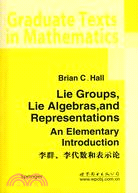人民幣定價:43 元
定價
:NT$ 258 元優惠價
:87 折 224 元
絕版無法訂購
商品簡介
目次
商品簡介
This book provides an introduction to Lie groups, Lie algebras, and representation theory, aimed at graduate students in mathematics and physics.Although there are already several excellent books that cover many of the same topics, this book has two distinctive features that I hope will make it a useful addition to the literature. First, it treats Lie groups (not just Lie alge bras) in a way that minimizes the amount of manifold theory needed. Thus,I neither assume a prior course on differentiable manifolds nor provide a con-densed such course in the beginning chapters. Second, this book provides a gentle introduction to the machinery of semisimple groups and Lie algebras by treating the representation theory of SU(2) and SU(3) in detail before going to the general case. This allows the reader to see roots, weights, and the Weyl group in action in simple cases before confronting the general theory.
The standard books on Lie theory begin immediately with the general case:a smooth manifold that is also a group. The Lie algebra is then defined as the space of left-invariant vector fields and the exponential mapping is defined in terms of the flow along such vector fields. This approach is undoubtedly the right one in the long run, but it is rather abstract for a reader encountering such things for the first time. Furthermore, with this approach, one must either assume the reader is familiar with the theory of differentiable manifolds (which rules out a substantial part of ones audience) or one must spend considerable time at the beginning of the book explaining this theory (in which case, it takes a long time to get to Lie theory proper).
The standard books on Lie theory begin immediately with the general case:a smooth manifold that is also a group. The Lie algebra is then defined as the space of left-invariant vector fields and the exponential mapping is defined in terms of the flow along such vector fields. This approach is undoubtedly the right one in the long run, but it is rather abstract for a reader encountering such things for the first time. Furthermore, with this approach, one must either assume the reader is familiar with the theory of differentiable manifolds (which rules out a substantial part of ones audience) or one must spend considerable time at the beginning of the book explaining this theory (in which case, it takes a long time to get to Lie theory proper).
目次
Part I General Theory
Matrix Lie Groups
1.1 Definition of a Matrix Lie Group
1.1.1 Counterexa~ples
1.2 Examples of Matrix Lie Groups
1.2.1 The general linear groups GL(n;R) and GL(n;C)
1.2.2 The special linear groups SL(n; R) and SL(n; C)
1.2.3 The orthogonal and special orthogonal groups, O(n) and SO(n)
1.2.4 The unitary and special unitary groups, U(n) and SU(n)
1.2.5 The complex orthogonal groups, O(n; C) and SO(n; C)
1.2.6 The generalized orthogonal and Lorentz groups
1.2.7 The symplectic groups Sp(n; R), Sp(n;C), and $p(n)
1.2.8 The Heisenberg group H .
1.2.9 The groups R, C*, S1, and Rn
1.2.10 The Euclidean and Poincaxd groups E(n) and P(n; 1)
1.3 Compactness
1.3.1 Examples of compact groups
1.3.2 Examples of noncompa groups
1.4 Connectedness
1.5 Simple Connectedness
1.6 Homomorpliisms and Isomorphisms
1.6.1 Example: SU(2) and S0(3)
1.7 The Polar Decomposition for S[(n; R) and SL(n; C)
1.8 Lie Groups
1.9 Exercises
2 Lie Algebras and the Exponential Mapping
2.1 The Matrix Exponential
2.2 Computing the Exponential of a Matrix
2.2.1 Case 1: X is diagonalizable
2.2.2 Case 2: X is nilpotent
2.2.3 Case 3: X arbitrary
2.3 The Matrix Logarithm
2.4 Further Properties of the Matrix Exponential
2.5 The Lie Algebra of a Matrix Lie Group
2.5.1 Physicists Convention
2.5.2 The general linear groups
2.5.3 The special linear groups
2.5.4 The unitary groups
2.5.5 The orthogonal groups
2.5.6 The generalized orthogonal groups
2.5.7 The symplectic groups
2.5.8 The Heisenberg group
2.5.9 The Euclidean and Poincar6 groups
2.6 Properties of the Lie Algebra
2.7 The Exponential Mapping
2.8 Lie Algebras
2.8.1 Structure constants
2.8.2 Direct sums
2.9 The Complexification of a Real Lie Algebra
2.10 Exercises
3 The Baker-Campbell-Hausdorff Formula
3.1 The Baker-Campbell-Hausdorff Formula for the Heisenberg Group
3.2 The General Baker-Campbell-Hausdorff Formula
3.3 The Derivative of the Exponential Mapping
3.4 Proof of the Baker-Campbell-Hausdorff Formula
3.5 The Series Form of the Baker-Campbell-Hausdorff Formula
3.6 Group Versus Lie Algebra Homomorphisms
3.7 Covering Groups
3.8 Subgroups and Subalgebras
3.9 Exercises
4 Basic Representation Theory
4.1 Representations
4.2 Why Study Representations?
4.3 Examples of Representations
4.3.1 The standard representation
4.3.2 The trivial representation
4.3.3 The adjoint representation
4.3.4 Some representations of S(,1(2)
4.3.5 Two unitary representations of S0(3)
4.3.6 A unitary representation of the reals
……
Part II Semistmple Theory
References
Index
Matrix Lie Groups
1.1 Definition of a Matrix Lie Group
1.1.1 Counterexa~ples
1.2 Examples of Matrix Lie Groups
1.2.1 The general linear groups GL(n;R) and GL(n;C)
1.2.2 The special linear groups SL(n; R) and SL(n; C)
1.2.3 The orthogonal and special orthogonal groups, O(n) and SO(n)
1.2.4 The unitary and special unitary groups, U(n) and SU(n)
1.2.5 The complex orthogonal groups, O(n; C) and SO(n; C)
1.2.6 The generalized orthogonal and Lorentz groups
1.2.7 The symplectic groups Sp(n; R), Sp(n;C), and $p(n)
1.2.8 The Heisenberg group H .
1.2.9 The groups R, C*, S1, and Rn
1.2.10 The Euclidean and Poincaxd groups E(n) and P(n; 1)
1.3 Compactness
1.3.1 Examples of compact groups
1.3.2 Examples of noncompa groups
1.4 Connectedness
1.5 Simple Connectedness
1.6 Homomorpliisms and Isomorphisms
1.6.1 Example: SU(2) and S0(3)
1.7 The Polar Decomposition for S[(n; R) and SL(n; C)
1.8 Lie Groups
1.9 Exercises
2 Lie Algebras and the Exponential Mapping
2.1 The Matrix Exponential
2.2 Computing the Exponential of a Matrix
2.2.1 Case 1: X is diagonalizable
2.2.2 Case 2: X is nilpotent
2.2.3 Case 3: X arbitrary
2.3 The Matrix Logarithm
2.4 Further Properties of the Matrix Exponential
2.5 The Lie Algebra of a Matrix Lie Group
2.5.1 Physicists Convention
2.5.2 The general linear groups
2.5.3 The special linear groups
2.5.4 The unitary groups
2.5.5 The orthogonal groups
2.5.6 The generalized orthogonal groups
2.5.7 The symplectic groups
2.5.8 The Heisenberg group
2.5.9 The Euclidean and Poincar6 groups
2.6 Properties of the Lie Algebra
2.7 The Exponential Mapping
2.8 Lie Algebras
2.8.1 Structure constants
2.8.2 Direct sums
2.9 The Complexification of a Real Lie Algebra
2.10 Exercises
3 The Baker-Campbell-Hausdorff Formula
3.1 The Baker-Campbell-Hausdorff Formula for the Heisenberg Group
3.2 The General Baker-Campbell-Hausdorff Formula
3.3 The Derivative of the Exponential Mapping
3.4 Proof of the Baker-Campbell-Hausdorff Formula
3.5 The Series Form of the Baker-Campbell-Hausdorff Formula
3.6 Group Versus Lie Algebra Homomorphisms
3.7 Covering Groups
3.8 Subgroups and Subalgebras
3.9 Exercises
4 Basic Representation Theory
4.1 Representations
4.2 Why Study Representations?
4.3 Examples of Representations
4.3.1 The standard representation
4.3.2 The trivial representation
4.3.3 The adjoint representation
4.3.4 Some representations of S(,1(2)
4.3.5 Two unitary representations of S0(3)
4.3.6 A unitary representation of the reals
……
Part II Semistmple Theory
References
Index
主題書展
更多
主題書展
更多書展今日66折
您曾經瀏覽過的商品
購物須知
大陸出版品因裝訂品質及貨運條件與台灣出版品落差甚大,除封面破損、內頁脫落等較嚴重的狀態,其餘商品將正常出貨。
特別提醒:部分書籍附贈之內容(如音頻mp3或影片dvd等)已無實體光碟提供,需以QR CODE 連結至當地網站註冊“並通過驗證程序”,方可下載使用。
無現貨庫存之簡體書,將向海外調貨:
海外有庫存之書籍,等候約45個工作天;
海外無庫存之書籍,平均作業時間約60個工作天,然不保證確定可調到貨,尚請見諒。
為了保護您的權益,「三民網路書店」提供會員七日商品鑑賞期(收到商品為起始日)。
若要辦理退貨,請在商品鑑賞期內寄回,且商品必須是全新狀態與完整包裝(商品、附件、發票、隨貨贈品等)否則恕不接受退貨。


























